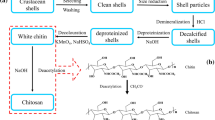Abstract
In this research, static adsorption of three polycyclic aromatic hydrocarbons (PAHs), naphthalene, acenaphthene, and fluorene, from aqueous solutions onto hypercrosslinked polymeric adsorbent within the temperature range of 288–308 K is investigated. Several isotherm equations are correlated with the equilibrium data, and the experimental data is found to fit the Polanyi-Dubinin-Manes model best within the entire range of concentrations, providing evidence that pore-filling is the dominating sorption mechanism for PAHs. The study shows that the molecular size of adsorbates has distinct influence on adsorption capacity of hypercrosslinked polymeric adsorbent for the PAHs; the larger the adsorbate molecular size, the lower the adsorption equilibrium capacity. Based on the Polanyi-Dubinin-Manes model, the molecular size of adsorbates was introduced to adjust the adsorbate molar volume. Plots of q v vs. (σε/V s) are collapsed to a single correlation curve for different adsorbates on hypercrosslinked polymeric resin.
Similar content being viewed by others
References
Dubinin M M. The potential theory of adsorption of gases and vapors for adsorbents with energetically nonuniform surfaces. Chem Rev, 1960, 60: 235–241
Wohleber D A, Manes M. Application of Polanyi adsorption potential theory to adsorption from solution on activated carbon. II. Adsorption of partially miscible organic liquids from water solution. J Phys Chem, 1971, 75: 61–64
Manes M, Hofer L J E. Application of the Polanyi adsorption potential theory to adsorption from solution on activated carbon. J Phys Chem, 1969, 73:584–590
Manes M. Activated carbon adsorption fundamentals. In: Meyers R A, ed. Encyclopedia of Environmental Analysis and Remediation. New York: John Wiley & Sons, 1998, Vol. 1, 26–68
Li L, Quinlivan P A, Knappe N U. Predicting adsorption isotherms for aqueous organic micropollutants from activated carbon and pollutant properties. Environ Sci Technol, 2005, 39: 3393–3400
Middaugh D P, Thomas R L, Lantz S E, Heard C S, Mueller J G. Field scale testing of a hyperfiltration unit for removal of creosote and pentachlorophenol from groundwater: chemical and biological assessment. Arch Environ Contam Technol, 1994, 26(3): 309–319
Schroder H F. Non-biodegradable wastewater compounds treated by ozone or ozone/UV—Conversion monitoring by substance-specific analysis and biotoxicity testing. Water Sci Technol, 1996, 33(6): 331–338
Zeng Y, Andrew Hong P K, Wavrek D A. Integrated chemical-biological treatment of benzo[a]pyrene. Environ Sci Technol, 2000, 34(4): 854–862
Engwall M A, Pignatello J J, Grasso D. Degradation and detoxification of the wood preservative creosote and pentachlorophenol in water by the photo-Fenton reaction. Water Res, 1999, 33(5): 1151–1158
Nadarajah N, Hamme J V, Pannu J, Singh A. Enhanced transformation of polycyclic aromatic hydrocarbons using a combined Fenton’s reagent, microbial treatment and surfactants. Appl Microbiol Biotechnol, 2002, 59: 540–544
Fasnacht M P, Blough N V. Kinetic analysis of the photodegradation of polycyclic aromatic hydrocarbons in aqueous solution. Aquat Sci, 2003, 65: 352–358
Bertilsson S, Widenfalk A. Photochemical degradation of PAHs in freshwaters and their impact on bacterial growth-influence of water chemistry. Hydrobiologia, 2002, 469: 23–32
Johnsen A R, Karlson U. Evaluation of bacterial strategies to promote the bioavailability of polycyclic aromatic hydrocarbons. Appl Microbiol Biotechnol, 2004, 63: 452–459
Lotfabad S K, Gray M R. Kinetics of biodegradation of mixtures of polycyclic aromatic hydrocarbons. Appl Microbiol Biotechnol, 2002, 60: 361–365
Waiters R W, Luthy R G. Equilibrium adsorption of polycyclic aromatic hydrocarbons from water onto activated carbon. Environ Sci Technol, 1984, 18(6): 395–403
Zhu L Z, Chen B L, Luo Y. The properties and mechanism s for organobentonites to sorb polycyclic aromatic hydrocarbons in water. Acta Scientiae Circumstantiae (in Chinese), 2000, 20(1): 21–26
Ake C L, Wiles M C, Huebner H J, Mcdonald T J, Cosgriff D, Richardson M B, Donnelly K C, Phillips T D. Porous organoclay composite for the sorption of polycyclic aromatic hydrocarbons and pentachlorophenol from groundwater. Chemosphere, 2003, 51: 835–844
Jonker M T O, Koelmans A A. Sorption of polycyclic aromatic hydrocarbons and polychlorinated biphenyls to soot and soot-like materials in the aqueous environment mechanistic considerations. Environ Sci Technol, 2002, 36(17): 3725–3734
Xu Z Y, Zhang Q X, Fang H H P. Application of porous resin sorbents in industrial wastewater treatment and resource recovery. Cr R Env Sc, 2003, 33: 1–27
Shiu W Y, Ma K C. Temperature dependence of physical-chemical properties of selected chemicals of environmental interest. I. Mononuclear and polynuclear aromatic hydrocarbons. J Phys Chem Ref Data, 2000, 29(1): 41–130
Mastral A M, Garcı’a T, Calle’n M S, Murillo R, Navarro M V, Lo’pez J M. Sorbent characteristics influence on the adsorption of PAC: I. PAH adsorption with the same number of rings. Fuel Proc Tech, 2002, 77–78: 373–379
Mastral A M, Garcı’a T, Calle’n M S, Murillo R, Lo’pez J M, Navarro M V. Influence of sorbent characteristics on the adsorption of PAC II. Adsorption of PAH with different numbers of rings. Fuel Proc Tech, 2002, 77–78: 365–372
Xia G S, Ball W P. Adsorption-partitioning uptake of nine low-polarity organic chemicals on a natural sorbent. Environ Sci Technol, 1999, 33(2): 262–269
Ran Y, Xing B S, Rao P S C, Fu J M. Importance of adsorption (Hole-Filling) mechanism for hydrophobic organic contaminants on an aquifer kerogen isolate. Environ Sci Technol, 2004, 38(16): 4340–4348
Author information
Authors and Affiliations
Corresponding author
Additional information
Supported by the National Natural Science Foundation of China (Grant No. 50408025)
Rights and permissions
About this article
Cite this article
Long, C., Li, A., Hu, D. et al. Description of adsorption equilibrium of PAHs on hypercrosslinked polymeric adsorbent using Polanyi potential theory. Sci. China Ser. B-Chem. 51, 586–592 (2008). https://doi.org/10.1007/s11426-007-0111-z
Received:
Accepted:
Published:
Issue Date:
DOI: https://doi.org/10.1007/s11426-007-0111-z




